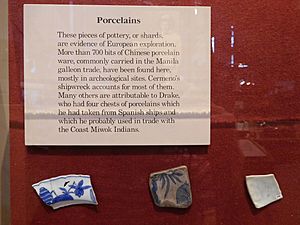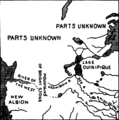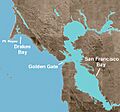New Albion facts for kids
Quick facts for kids
New Albion
|
|
|---|---|
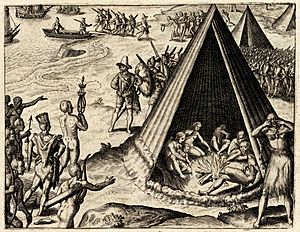
Drake's Landing in New Albion, 1579, engraving published by Theodor De Bry, 1590
|
|
| Established | 17 June 1579 |
| Abandoned | 23 July 1579 |
| Named for | the white cliffs of England and the archaic name of Britain |
| Claimant | Sir Francis Drake |
New Albion, also known as Nova Albion (which means "New Britain"), was a name given to a part of North America. It was claimed by Sir Francis Drake for England in 1579. This happened when he landed on the west coast of North America. This claim later helped England justify its expansion across America. Drake's landing spot is now believed to be Drake's Cove. This cove is part of the Point Reyes National Seashore.
Drake had been exploring the Pacific coast. He had found treasure from Spanish towns and ships. He needed a safe place to fix his ship, the Golden Hind. He found this safe spot on June 17, 1579. He and his crew landed on the Pacific coast at Drakes Bay in Northern California. While they were there, Drake and his crew became friends with the Coast Miwok people. These people lived near where Drake landed. Drake named the area Nova Albion, or New Albion. He claimed this land for Queen Elizabeth I. This act had important long-term effects on history. Drake sailed away on July 23, 1579. He did not leave a colony behind. He then sailed around the world and returned to England in September 1580.
Over many years, people looked for Drake's New Albion landing site. Many maps and sailors thought the area near Point Reyes was the spot. In the 20th and 21st centuries, clear proof was found. This included details about Drake's contact with the Coast Miwok people. Also, pieces of porcelain were found. These pieces were from Drake's ship. All this research led to the site being named a National Historic Landmark in 2012. It was also named a California Historical Landmark in 2021.
Contents
Drake's Amazing Journey
Why Drake Sailed West
In the late 1500s, England and Spain were not friendly. They had different religions and wanted more power. Sir Francis Drake planned to raid Spanish settlements on the Pacific Coast. He got money from investors. It is also likely that Queen Elizabeth I secretly supported him. She might have given him permission to be a privateer. This meant he could attack enemy ships for England. Drake started his journey on November 15, 1577. He knew his actions would upset Spain's King Philip II. But he also knew Queen Elizabeth would support him.
Drake successfully took much treasure from Spanish towns and ships. These were along King Philip's Pacific coast colonies. After this, Drake sailed north. He hoped to find a shortcut back to England. This shortcut was called the Strait of Anián. People thought it was a waterway connecting the Pacific and Atlantic oceans. This idea was like a fantasy, similar to the Fountain of Youth. People thought it might be around 40 degrees north. Drake might have sailed as far north as 48 degrees. But bad weather stopped him. He could not find the strait. So, Drake looked for a safe harbor. He needed to fix his ship, the Golden Hind. Then he planned to sail around the world to get home.
Drake's Landing and Claim
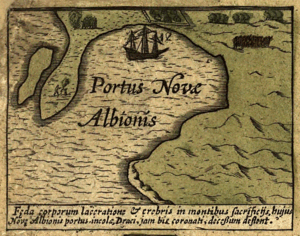
Before Drake, the western coast of North America was not fully explored. Juan Rodriguez Cabrillo had sailed there for Spain in 1542. Drake wanted to avoid more fights with Spain. So, he sailed far northwest of where Spain had claimed land. He wanted to find a hidden spot to get his ship ready for the trip back to England.
On June 5, 1579, Drake's ship briefly landed at South Cove, Cape Arago, in Oregon. From there, Drake sailed south. He was looking for a good harbor to fix his damaged ship. On June 17, Drake and his crew found a safe cove. They landed on the Pacific coast in what is now Northern California. While on shore, he claimed the area for Queen Elizabeth I. He called it Nova Albion or New Albion. He chose this name for two reasons. First, the white cliffs he saw looked like the cliffs in England. Second, Albion was an old name for Great Britain. To show his claim, Drake put up a brass plate. It had Queen Elizabeth's name and the date of his arrival. It also said the land and people were given to her. A sixpence coin with Elizabeth's picture was placed under the plate.
After setting up a fort and tents, the crew worked for weeks. They prepared for their trip around the world. They did this by careening their ship, Golden Hind. This meant tilting the ship to clean and fix its bottom. Drake had friendly meetings with the Coast Miwok people. He also explored the land by walking. He crossed Inverness Ridge to visit a village. When his ship was ready, Drake and his crew left New Albion on July 23. The next day, they stopped at the Farallon Islands. There, the crew hunted seals for meat. On July 25, they sailed west across the Pacific. The Golden Hind finally returned to England in September 1580.
The People and the Land
Drake wrote detailed descriptions of the people he met. He described their houses, feathered baskets, ceremonies, and language. Because of these details, experts know these people were the Coast Miwok. Their traditional home was the Point Reyes area in Marin County.
When Drake's crew landed, the Coast Miwok first came with bows and arrows. They were careful about these new people. But Drake quickly made them feel safe. Soon, many unarmed Miwok visited his camp every day. Drake's crew saw the Miwok crying and hurting themselves. Drake thought this was a sign of worship. He believed the Miwok thought he and his crew were gods. However, this was actually a Miwok mourning custom. The Miwok likely thought the English visitors were relatives who had returned from the dead.
One day, a large group of Coast Miwok honored Drake in a special way. They put chains around his neck. They placed a scepter in his hand. They put a crown of feathers on his head. It was as if they were making him king. England later used this event to claim legal power over the land. They saw it as the owners giving up their power.
After gaining the Miwok's trust, Drake explored the land. He visited their villages. With some crew members, Drake walked on a Coast Miwok trail. They crossed the Inverness Ridge and went into what is now the Olema Valley. Drake's chaplain, Fletcher, described the village houses. He said they were round buildings built partly underground. Their roofs came together at the top like church spires. Fletcher also wrote about the Coast Miwok baskets. He said they were waterproof, shaped like deep bowls, and covered with colored feathers. Only the Coast Miwok and a few nearby groups made such baskets.
Fletcher was the first person to write down words from any of California's 64 native languages. He recorded five Coast Miwok words. Experts later confirmed these words were definitely Coast Miwok. This is proof that Drake met the Coast Miwok people. Overall, the Miwok and the English were peaceful and friendly. The Miwok seemed sad when the Golden Hind sailed away.
Fletcher also wrote about the weather. He said the summer weather near the ship repair area was unpleasant. He noted the constant cold, lack of sun, and strong winds. But across the Inverness Ridge, he found a different climate. He saw a rich and fertile land. Fletcher wrote that the inland area was "farre different from the shoare, a goodly country and fruitful soyle, stored with many blessings fit for the use of man."
Fletcher also wrote about animals new to the English. He described "very large and fat Deere" and "a multitude of a strange kinde of Conies." The "fat Deere" were likely Roosevelt Elk. The "conies" were probably gophers. All of Fletcher's notes about New Albion match the geography of Point Reyes perfectly.
New Albion's Impact on History

The claim of New Albion had big effects on history. Drake did not stay long, and England did not immediately follow up. But it was England's first claim of power on the North American Pacific coast. England's later trips to this coast were rare. So, Nova Albion was mostly a name on world maps. This name was important because it showed England's ability to build an empire in the Americas. Drake's New Albion claim was a smart part of England's new plan to expand. It influenced Queen Elizabeth's policies and England's future.
The New Albion claim showed that England wanted more than just revenge against Spain. It influenced others like Humphrey Gilbert and Walter Raleigh to start similar projects. England's claim rejected the idea that the Pope could decide who owned land. Instead, it said that physical presence gave a country the right to claim land. This led to the idea of New Albion as "the back side of Virginia." This meant England believed it had rights to land from one ocean to the other. The claim was important for British plans for centuries. It even helped Britain's right to the fur trade on the Northwest Coast. Its last big impact was in the Oregon Treaty of 1846. This treaty divided Oregon between Canada and the United States.
Finding the Landing Site
Early Ideas
Starting in the 1600s, maps showed Drakes Bay as Drake's landing spot. In 1793, George Vancouver studied the site. He agreed it was in Drakes Bay. Professor George Davidson of the United States Coast and Geodetic Survey also studied the area. In 1886, he said Drake's harbor was Drakes Bay, near Point Reyes. This is about 30 miles (50 km) north of San Francisco. Davidson reported that "Drakes Bay is a capital harbor in northwest winds, such as Drake encountered. It is easily entered, sheltered by high lands, and a vessel may anchor in three fathoms, close under the shore in good holding ground." Davidson wrote more to support Drakes Bay in 1890 and 1908.
20th Century Discoveries
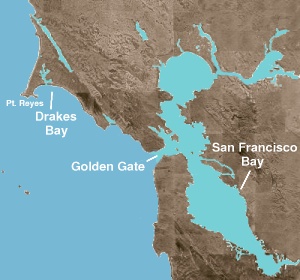
In 1947, archaeologist Robert F. Heizer looked at old reports of Drake's time at New Albion. He confirmed that "Drake must have landed in territory occupied by the Coast Miwok-speaking natives." Heizer concluded that "in June 1579, then, Drake probably landed in what is now known as Drake's Bay."
Since 1949, the Drake Navigators Guild in California has supported the Drakes Bay theory. Captain Adolph S. Oko, Jr., Admiral Chester W. Nimitz, and Raymond Aker were key supporters. Oko wrote that "Many other correlative facts have been ... found true to the Drake's Cove site as part of the total body of evidence. The weight of evidence truly establishes Drake's Cove as the nodal point of Nova Albion." Nimitz believed the site would become as famous as Roanoke, Jamestown, and Plymouth. In 1956, Sir Alex A. Cumming, who managed Drake's old home, also agreed. He said, "That little cove at the mouth of the Estero, sheltered from the wind, protected from the sea and hidden from hostile eyes, must have been a welcome sight, and I believe that Divine Providence guided him to it." In 1978, historian Samuel Eliot Morison wrote that "Drakes Bay is correctly so named, that here he spent five weeks, repaired the Golden Hind, sang songs for the Indians, and marched up country."
Aker studied Drake's voyage in detail. He supported the Point Reyes site. He noted that the official record said the colony was at 38 degrees north. Drake's Cove, in Marin County, matches descriptions. It has white cliffs like England's coast. Aker also explained that sandbars in the cove change over time. He predicted a sand spit would reappear, and it did in 2001. This matched an old map.
Proof also came from nearly 100 pieces of 16th-century Chinese export porcelain. These were found near Drake's Cove. Experts like Clarence Shangraw and Edward Von der Porten said these pieces "must fairly be attributed to Francis Drake's Golden Hind visit of 1579." These porcelain pieces are the oldest Chinese porcelains found in the Pacific. They were found by several groups. These pieces were from porcelain dishes Drake took from a Spanish treasure ship. He left them behind when he fixed his ship.
Shangraw and Von der Porten identified these porcelains. They separated Drake's pieces from those of the 1595 shipwreck of the San Agustin. The San Agustin pieces washed ashore from the sunken ship. Drake's porcelains were found in old Native American trash piles. They had clean breaks and no wear from the ocean. The shipwreck pieces were worn by the surf. This showed they were from two different ships. Drake's stolen cargo included high-quality porcelain from Jingdezhen. The San Agustin carried lower-quality porcelain made later. These differences helped tell the two groups of items apart.
21st Century Discoveries
In 2003, Sir Simon Cassels, a high-ranking officer in the Royal Navy, studied the site. He said that "the weight of evidence... bears heavily on only one and the same site for careening the Golden Hind: the estuary within what for more than 100 years has been named Drakes Bay."
Dr. Marco Meniketti used X-ray tests on the porcelain pieces. He tested ceramics from shipwrecks and from Drake's site. His tests showed that the shipwreck porcelains and Drake's ceramics were from different ships. He said they had different chemicals. Aker believed that pieces with clean breaks were Drake's. Pieces worn by water were from the shipwreck.
Historian Dr. John Sugden looked at many possible Drake landing sites. He said, "No aspect of Drake's career has suffered more false leads than the site of Nova Albion." Sugden concluded that "the evidence overwhelmingly favours Drake's Estero in Drakes Bay." He felt it was time for the site to be officially recognized.
Official Recognition
The U.S. Department of the Interior officially recognizes Drake's Cove as the landing site. The cove is in Drakes Estero, which is part of Drakes Bay. It is in Marin County, California, near Point Reyes. On October 17, 2012, the Drakes Bay Historic and Archaeological District was named a new National Historic Landmark. This site has been studied more than any other possible Drake landing spot.
This honor means the site's artifacts show one of the first times Native Americans met European explorers on the U.S. west coast. This is based on two events: Sir Francis Drake's 1579 landing and the 1595 shipwreck of Sebastian Rodriguez Cermeño's San Agustin.
In October 2021, California State Parks named Site of New Albion as California Historical Landmark number 1061. This 215-acre site, Drake's Cove, is inside Point Reyes National Seashore. The state says, "New Albion is the landing site and encampment of Sir Francis Drake's expedition to California in 1579, located in the coast of Marin County." It lists important events there: "Includes sites of Drake's fort, the careening of the Golden Hind, the abandonment of Tello's bark, and the meetings with the Coast Miwok peoples."
The Federated Indians of Graton Rancheria also recognize that the Coast Miwok people first met Europeans with Sir Francis Drake. The Coast Miwok Tribal Council of Marin also agrees that their ancestors met Drake in 1579.
Both the Oregon State Parks and Oregon Historical Society believe Drake anchored at Cape Arago. They agree he then sailed south to find a place to fix his ship.
Other Ideas for the Landing Site
More than 30 other places have been suggested as Drake's landing site. Many people have written about New Albion's location. Geographer George Davidson said much of the confusion came from people who did not understand sailing.
One suggested location is San Francisco Bay, California. Robert H. Power thought Drake's New Albion was inside San Francisco Bay. He believed it was near Point San Quentin. He argued that an old map matched the area if adjusted.
In 2003, R. Samuel Bawlf suggested Drake landed on Vancouver Island in Canada. He thought Drake fixed his ship in Whale Cove, Oregon. He also believed that the official story of Drake's voyage was changed. This was to hide how far Drake actually explored.
The Mystery of a Colony
Some people wonder if Drake left men behind to start a colony. This idea comes from a difference in how many crew members were counted. However, it is unlikely Drake would have left settlers. His trip was not planned for starting colonies. Drake also knew England would have trouble supporting a colony so far away. He likely avoided leaving an English outpost. The only person reported left behind was N. de Morena, a European ship pilot who was sick. Spanish records say he got better and walked to Mexico. There, he reported to the authorities.
The crew count difference is about 20 men. This is between the number of men Drake had before California and when he reached the Moluccas. Spanish prisoners said Drake had about 80 men off Central America. Drake's cousin, John Drake, said there were 60 men at Ternate in the Moluccas. An old book, The World Encompassed, says there were 58 men at Vesuvius Reef. The idea of a colony is based on these numbers. The reason for this difference is still unknown.
The Fake Brass Plate
In the 1900s, a fake brass plate appeared. People thought it was the one Drake left at New Albion. English historian Richard Hakluyt described the real plate:
At our departure hence our General set up a monument of our being there, as also of her Majesty's right and title to the same; namely a plate, nailed upon a fair great post, whereupon was engraved her Majesty's name, the day and year of our arrival there, with the free giving up of the province and people into her Majesty's hands, together with her Highness' picture and arms, in a piece of six pence of current English money, under the plate, whereunder was also written the name of our General.
The real plate, which showed England's claim to the land, has never been found. So, no one knows the exact spot where Drake put up his monument.
In 1936, a fake plate, known as Drake's Plate of Brass, became public. For decades, many believed it was the real one. The University of California, Berkeley accepted it as real. But some people had doubts. In the late 1970s, the plate failed metal tests. Scientists found it was a modern fake. In 2003, it was revealed that the fake plate was a practical joke among local historians. The joke got out of control and became a public hoax. It was embarrassing for those who had said it was real.
Images for kids
-
Drake's Landing in New Albion, 1579, engraving published by Theodor De Bry, 1590
-
The Hondius map The Vera Totius Expeditionis Navticae inset depicts Drake's encampment at New Albion, Portus Novas Albionis. The Latin word Portus denotes a port or harbor within a river or estuary near its mouth, strictly correlating with the geography of Drake's Cove.
-
Jonathan Carver's 1778 map shows the continuing Nova Albion claim.
-
Drakes Bay, northwest of San Francisco.
-
National Historic Landmark commemorating Sir Francis Drake, Sebastian Rodriguez Cermeño, and Coast Miwok people at Point Reyes, California
See also
 In Spanish: Nueva Albión para niños
In Spanish: Nueva Albión para niños






